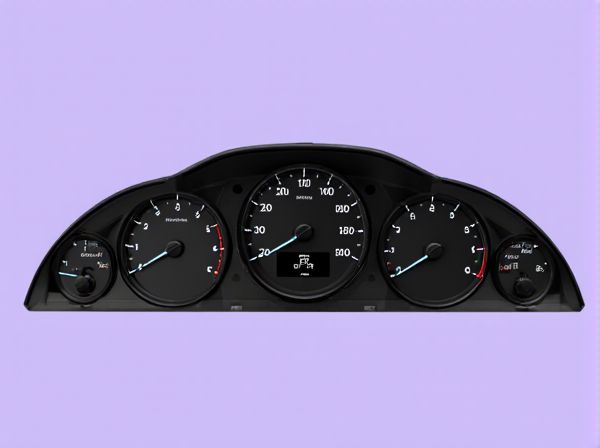
Photo illustration: 3D Instrument Cluster vs 2D Instrument Cluster
A 3D instrument cluster offers enhanced depth perception and visual clarity compared to a traditional 2D instrument cluster, improving your ability to quickly interpret vital driving information. The advanced graphics and layered display in 3D clusters provide a more immersive and intuitive user experience, aiding in safer and more efficient vehicle operation. While 2D clusters remain functional and straightforward, 3D clusters deliver cutting-edge technology that elevates dashboard readability and overall driver engagement.
Table of Comparison
| Feature | 3D Instrument Cluster | 2D Instrument Cluster |
|---|---|---|
| Display Type | Three-dimensional digital display with depth perception | Flat, traditional digital or analog display |
| Visual Clarity | Enhanced depth, improved readability in varying light conditions | Standard clarity, may struggle under direct sunlight |
| User Interface | Dynamic graphics, customizable layouts | Static graphics, limited customization |
| Technology Integration | Supports AR overlays and advanced sensor data | Basic data display, limited sensor integration |
| Cost | Higher manufacturing and repair cost | Lower cost, widely available |
| Driver Experience | Immersive, easier information processing | Standard, familiar interface |
| Energy Consumption | Moderate to high due to advanced display tech | Low, energy-efficient |
Introduction to Instrument Clusters
Instrument clusters serve as the primary interface for drivers to access critical vehicle information such as speed, fuel levels, and engine status. Traditional 2D instrument clusters display this data on flat screens with static gauges, while 3D instrument clusters enhance visualization by incorporating depth and dynamic animations for improved readability and user engagement. The shift from 2D to 3D technology represents a significant advancement in automotive dashboard design, offering enhanced situational awareness and a more intuitive driving experience.
What is a 2D Instrument Cluster?
A 2D instrument cluster presents vehicle information using flat, two-dimensional graphics displayed on an LCD or LED screen, offering essential data like speed, fuel level, and engine status. Unlike 3D instrument clusters that provide depth and more dynamic visuals, 2D clusters prioritize simplicity and clarity for quick readability. This traditional design remains common in many vehicles due to its cost-effectiveness and straightforward functionality.
What is a 3D Instrument Cluster?
A 3D instrument cluster is an advanced vehicle dashboard display that uses layered graphics to create the illusion of depth and dimension, enhancing readability and user engagement compared to traditional 2D clusters. Unlike 2D instrument clusters, which present flat, static information, 3D clusters utilize stereoscopic technology or parallax effects to display gauges, speedometers, and other critical data with dynamic visual depth. This innovation improves driver interaction by providing clearer, more intuitive information presentation, contributing to safer and more immersive driving experiences.
Key Differences: 3D vs 2D Instrument Clusters
3D instrument clusters offer enhanced depth perception and dynamic visuals compared to traditional 2D clusters, improving driver engagement and information clarity. These clusters utilize advanced LED or LCD technology with variable parallax effects, delivering real-time feedback and customizable displays that adapt to driving conditions. In contrast, 2D instrument clusters rely on flat graphics, providing basic, static information without the immersive spatial context or advanced animations found in 3D systems.
Advantages of 3D Instrument Clusters
3D instrument clusters provide enhanced depth perception and improved readability compared to traditional 2D displays, offering drivers a more intuitive and immersive interface. These clusters enable dynamic visualizations of speed, navigation, and vehicle diagnostics, increasing safety by reducing driver distraction. Advanced graphics and customizable layouts in 3D clusters improve user experience and adapt seamlessly to different driving conditions.
Benefits of 2D Instrument Clusters
2D instrument clusters offer clear advantages such as lower manufacturing costs and simpler integration into vehicle dashboards, making them more accessible for budget-conscious automotive markets. Their straightforward design ensures consistent readability and minimal distraction for drivers, enhancing overall safety. Maintenance and repair are easier with 2D clusters due to their established technology and fewer electronic components.
User Experience and Interface Comparison
3D instrument clusters provide enhanced depth perception and dynamic visuals, improving user engagement and readability compared to traditional 2D clusters. Their intuitive interface offers customizable layouts and real-time data interaction, enabling drivers to access critical information more efficiently. In contrast, 2D instrument clusters rely on static displays, limiting visual appeal and the ability to present complex data without clutter, thus affecting overall user experience negatively.
Technology and Innovation Behind 3D Clusters
3D instrument clusters utilize advanced stereoscopic display technology combined with layered LCD or OLED screens to create depth perception, enhancing driver interaction with real-time data. Incorporating sensor-based or eye-tracking systems, these clusters adapt visual content dynamically, improving readability and reducing distraction compared to traditional 2D clusters. Innovations such as augmented reality overlays and high-resolution graphics further position 3D clusters at the forefront of automotive cockpit technology, delivering immersive and intuitive user experiences.
Cost and Maintenance Considerations
3D instrument clusters generally incur higher initial costs due to advanced display technology and more complex software integration compared to traditional 2D clusters. Maintenance for 3D clusters often requires specialized diagnostic tools and trained technicians, potentially increasing service expenses over time. Conversely, 2D instrument clusters benefit from simpler design and widespread familiarity, resulting in lower repair costs and easier maintenance.
Future Trends in Automotive Instrument Clusters
3D instrument clusters offer enhanced depth perception and dynamic visualization, providing drivers with intuitive interfaces that improve dashboard readability and interaction. Future trends indicate a shift towards fully customizable digital displays integrating augmented reality (AR) and head-up display (HUD) technologies, which will surpass traditional 2D clusters by delivering contextual information in real-time. Automotive manufacturers are rapidly adopting advanced GPUs and AI-driven graphics rendering to create immersive and adaptive instrument clusters, elevating user experience and safety standards.
 caratoz.com
caratoz.com